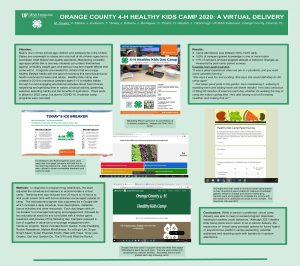- J. Anderson, J., Roberts, J., Rodriguez, J., Silvasy, T., Souers, M., Thralls, E., Wooten, H., Yarborough, J., Zabala, V. UF/IFAS Extension, Orange County, Orlando, FL
Situation: Nearly one in three school-age children and adolescents in the United States are overweight or obese, and only half of all children ages two to seventeen meet federal diet quality standards. Maintaining a healthy, age-appropriate diet is one way students can protect themselves against unhealthy weight gain and serious long-term health effects that come with it. Programs are needed for children that encourage healthy lifestyle habits with the goal of reversing this trend toward poor health outcomes for teens and adults. Healthy Kids Camp was created in 2019 to introduce campers ages 9-13 to healthy habits through fun and engaging educational activities about food choices, respecting and spending time in nature, physical activity, gardening, selective spending habits and the benefits of agriculture. Plans were in place for 2020 camp, but due to COVID-19, in-person camp programs were canceled. Methods: In response to programming restrictions, the team adjusted the schedule and delivery to accommodate a virtual camp. Teaching time was reduced from 20 hours to 10 hours to limit youth screen time with bonus activities encouraged outside of camp. The educational program was supported by a Google site which included a daily schedule, topic descriptions, materials, bonus activities and other resources. Each day began with an ice-breaker to encourage belonging and engagement, followed by two educational sessions and concluded with a review game, questions and preview of the following day. Campers received a box of supplies in advance to encourage engagement with hands-on projects. Results: Camp attendance was between 90%-100% daily. 100% of campers gained knowledge in one or more topics and 77% of campers showed targeted attitude or behavior changes as measured by post-camp parent surveys. Conclusions: While in-person is preferred, virtual camp delivery was able to meet or exceed program objectives leading to healthier youth behaviors.
 0
0

